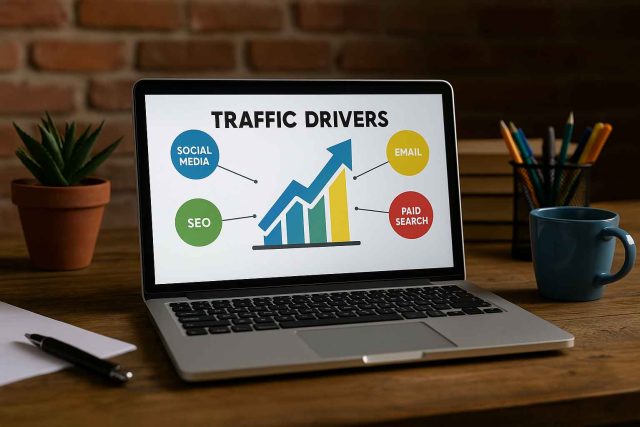How do pharma brands cut through the noise and bring the right audiences to their digital doorstep? As digital channels continue to expand, identifying and optimizing the best traffic drivers has become more critical than ever for pharma marketing teams.
In this article, we’ll unpack the most effective sources of website traffic in 2025—from organic search to paid campaigns—and explore how marketing leaders can turn clicks into meaningful engagement. By understanding these mechanisms, your team can allocate budgets smarter and build stronger connections with both HCPs and patients.
Table of Contents
- Organic Search: SEO Still Reigns Supreme
- Paid Media: Precision Through PPC and Programmatic
- Referral and Partner Channels
- Social, Email, and Owned Media Synergy
Organic Search: SEO Still Reigns Supreme
While new platforms may grab headlines, search remains the most reliable traffic driver for pharmaceutical websites. Google’s algorithm continues to evolve, prioritizing authoritative, well-structured, and medically accurate content.
For pharma marketers, this means more than just keyword stuffing. Google’s E-E-A-T principles (Experience, Expertise, Authoritativeness, Trustworthiness) demand high-quality, patient-friendly articles backed by credible sources.
In 2025, content strategy should focus on core disease-state education, treatment guides, and brand-specific FAQs. Search engine visibility is especially important for branded drug names, clinical trial updates, and patient assistance programs.
Integrating schema markup, optimizing for voice search, and improving page load speeds are additional tactics that boost organic rankings. Additionally, leveraging topic clusters helps build topical authority—Google now favors depth over breadth.
Sites that consistently deliver on user intent and offer trustworthy insights will outperform their competitors in SERPs.
Internal Reference: Pharma Marketing Network
Paid Media: Precision Through PPC and Programmatic
While organic traffic builds over time, paid channels allow for immediate visibility. Pay-per-click (PPC) advertising remains one of the most controllable traffic drivers, especially when used for branded campaigns or high-intent keywords.
Google Ads and Microsoft Advertising offer robust targeting for HCP and consumer audiences. But in 2025, more pharma brands are also shifting spend into programmatic display, native placements, and even connected TV (CTV) advertising.
For example, programmatic platforms now support data-driven segmentation, allowing marketers to target specific therapeutic interest groups or demographic profiles. These campaigns can be adjusted in real-time based on performance signals.
Attribution remains a challenge, so pharma marketers must integrate first-party analytics, consent-driven retargeting, and privacy-compliant cookies to track ROI effectively.
Platforms like eHealthcareSolutions.com offer healthcare-specific ad networks that connect pharma brands with verified HCPs and condition-specific patient audiences, making them ideal partners for boosting qualified traffic.
Referral and Partner Channels
Often overlooked, referral traffic can be one of the most valuable sources of new users. When trusted third-party sites link to your content, they lend credibility while sending motivated visitors your way.
High-authority referral sources might include:
- Health and wellness publications
- Academic medical journals
- Online CME platforms
- Influencer blogs and advocacy group websites
For branded drugs or condition-specific content, referral links from prescribing information sites or formulary pages can also be impactful.
Establishing co-branded educational content with advocacy groups or sponsorships with medical publishers enhances referral traffic quality. These collaborations not only boost visibility but also nurture brand trust.
Tracking UTM parameters on these partner links allows teams to analyze referral traffic performance in detail and adjust campaigns accordingly.
Social, Email, and Owned Media Synergy
Pharma marketers are increasingly investing in their owned media ecosystems—including blogs, portals, and apps—which can act as sustainable traffic drivers when integrated with social and email campaigns.
Social media remains a mixed bag in pharma due to regulatory restrictions. Still, platforms like LinkedIn and YouTube offer viable engagement avenues for professional education and brand awareness. Short-form videos, webinars, and live Q&A sessions drive traffic to deeper resources on branded websites.
Email marketing continues to offer strong ROI when deployed with segmented lists and triggered content journeys. For HCP audiences, medical education updates and case studies tend to perform well. For patient segments, newsletters offering condition-specific tips and product news foster ongoing engagement.
Consistency and personalization across these channels increase repeat visits and encourage user interaction. Moreover, integrating these touchpoints into CRM platforms creates a closed-loop marketing system that nurtures leads across the funnel.
Conclusion
Effective traffic drivers for pharma websites don’t rely on one channel alone. The best strategies blend SEO, paid media, referral partnerships, and owned content efforts to create a sustainable and compliant digital presence.
By understanding where your audience is and how they engage, you can refine each channel’s contribution and optimize for conversions—not just visits. Ultimately, the right mix depends on your brand’s objectives, regulatory constraints, and audience preferences.
Continually testing and refining your strategy will ensure your digital footprint stays strong and your content remains a trusted destination for patients and providers alike.
FAQs
What are the most effective traffic drivers for pharma websites?
SEO, paid search, programmatic ads, referral links, and email marketing remain top-performing traffic channels for pharma in 2025.
How can pharma marketers improve SEO for brand websites?
Focus on authoritative content, technical SEO (schema, speed, mobile), and user intent to boost rankings.
Is paid media still relevant in pharma marketing?
Yes. Paid media offers immediate visibility and precision targeting—especially when paired with healthcare-specific networks.
Can pharma use social media effectively?
Platforms like LinkedIn and YouTube are increasingly pharma-friendly and allow for compliant, engaging campaigns.
Where can I learn more about healthcare marketing trends?
Explore industry updates at Pharma Marketing Network and digital advertising resources at eHealthcareSolutions.com.
This content is not medical advice. For any health issues, always consult a healthcare professional. In an emergency, call 911 or your local emergency services.
